Who's Who
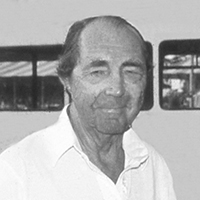
von Blixen-Finecke, Hans
Discipline : Horseman
Born : 1916
Died : 2005
Hans von Blixen-Finecke came from a famous family of equestrians and adventurers. His father was a romantic figure: cavalry officer, steeplechase and flat-race jockey and Olympic competitor – winning the Dressage Bronze Medal in the 1912 Olympics. He was also one of the early aviators and died while Hans was still just a toddler in a flying accident, flying from one racecourse to another to ride in another race.
Hans Junior followed in his father’s footsteps and joined the Swedish Cavalry, rising to the rank of Lieutenant-Colonel and was CO of the Swedish Army Equitation Centre at Stromsholm from 1959-64. During his time in the army, he competed successfully as a steeplechase jockey and was champion amateur in Sweden in 1945/6. He turned to Eventing and Dressage and was Swedish Eventing Champion for many years and represented Sweden in the Three Day Event at the Helsinki Olympics in 1952, winning team and individual gold riding the 7/8th bred Jubal and again in Stockholm in 1956. At the 1952 Games, he loaned to Major Henri St Cyr another horse he trained, Master Rufus, and the combination won the Olympic Gold medal.
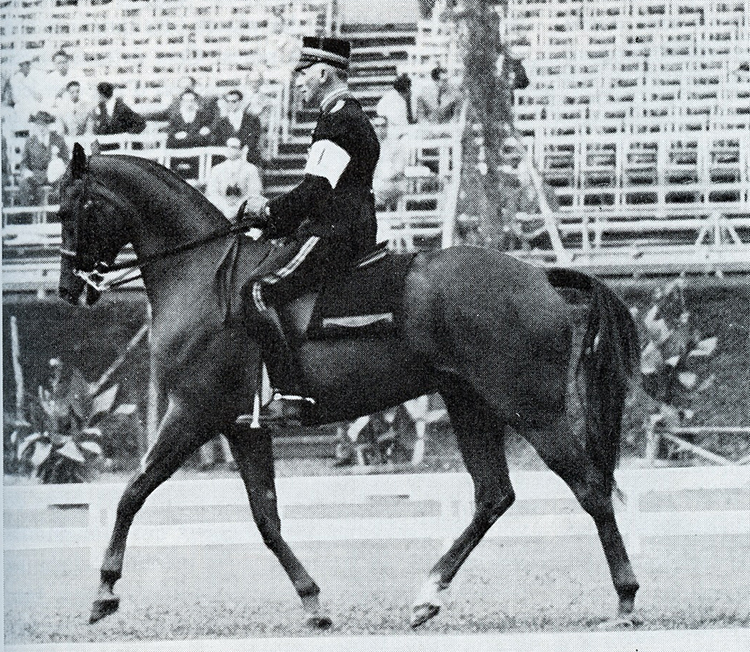
Henri St Cyr
In 1964 he left the army and moved to England, where he established his own Equestrian centre in Surrey before moving in the early 70’s to Cornwall.
In 1975, he started working with the Bartle family, teaching Jane and Christopher. At the 1984 Games, both of them – with the Baron’s help – competed in the dressage with Jane riding Pinocchio and Chris on Wily Trout. He would come to the Yorkshire Riding Centre several times a year to conduct clinics.
His reputation as a trainer spread and he travelled to give clinics all over the world especially in the USA and then later in Australia. He wrote two books The Art of Riding (1993) followed by the Art of Training (1996).
For a military man, and an eventer back in the days when the fences were fearsome, Hans von Blixen-Finecke was also something of a poet, looking to the aesthetic side of equestrian sport as much as the athletic. He sets out his credo in the introduction to his book, The Art of Training.
“I have chosen to include the element of ‘Art’ in the title of this book. If by art we mean the feeling of personal involvement: aesthetically, musically, as well as the appreciation of harmony and grace in the fluency of movement in this continuous exchange of information and execution that goes on between the trainer and his horse, then, surely we experience something which has raised itself above the mechanical craft. The training of the horse and rider top act together is based on a mutual respect and understanding and only then can reach the highest levels of beauty, balance, and rhythm. Although this book deals mainly with the practical side of training, I am anxious not to lose the artistic experience. Dressage must not be downgraded to mechanical tricks. It must remain a means to an end, not become an end in itself.”
A cavalry officer for most of his life, ‘the Baron’ drew attention to the sign on the wall of the indoor: When Arts goes out, Abuse takes over…”
Blixen-Finecke had a very logical and ordered approach to training (an approach that Christopher Bartle obviously shares) and his work follows the classical training scale. Consider his thoughts on collection:
“Work in collection, with the increased dorsiflexion of the back, the further engagement of the hind legs and the raising of the head and neck to an elevated or collected outlines, puts the horse under considerable mental and physical pressure. For lasting results, the ‘engagement’ behind and the elevation of the neck must come gradually by consent as he becomes more athletic. If it is produced quickly by artificial means, we have made the horse work with these parts in blockage. We have violated the natural, coordinated movement and reduced the economic use of his muscular power, properties which, once they are lost, are difficult and often impossible to restore.”
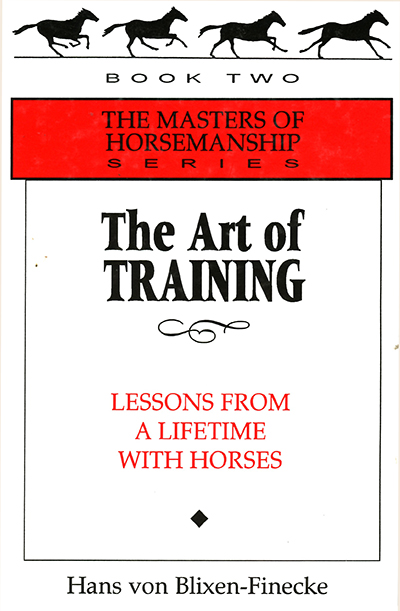 And his book contains some enlightening illustrations – this one shows the rider in vertical position for schooling on the flat:
And his book contains some enlightening illustrations – this one shows the rider in vertical position for schooling on the flat:
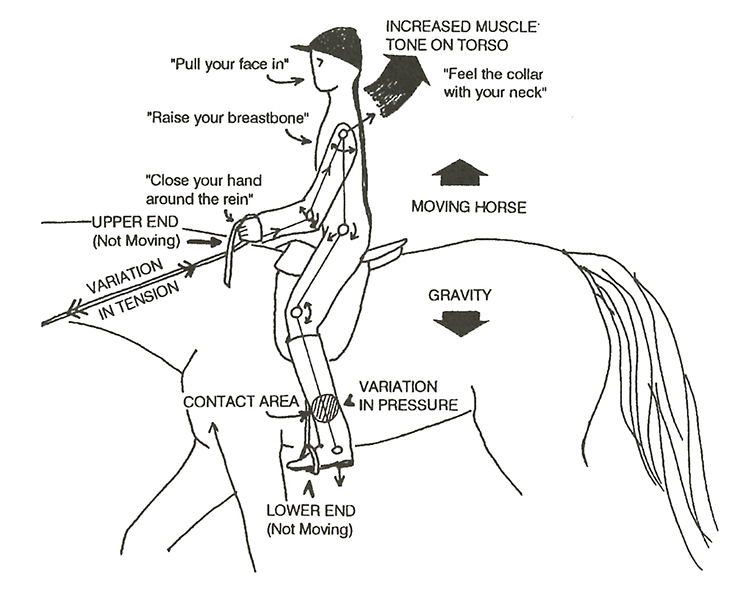
Now the forward position:
DO
– Adjust the stirrup leather 2 or 3 holes shorter than the vertical position
– Reach out toward the horse’s mouth with both arms.
– Fold the upper body forward and downward from the hips.
– Move the seat backward toward the cantle just out of the saddle.
– Adjust the reins for contact.
– Look forward over the horse’s head.
Again, illustrating the centered position:
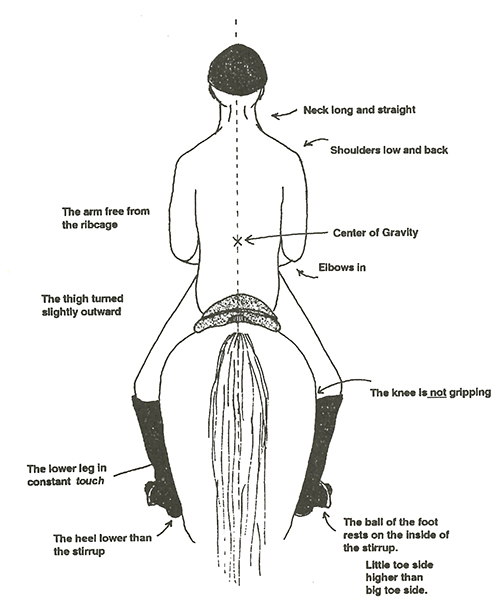
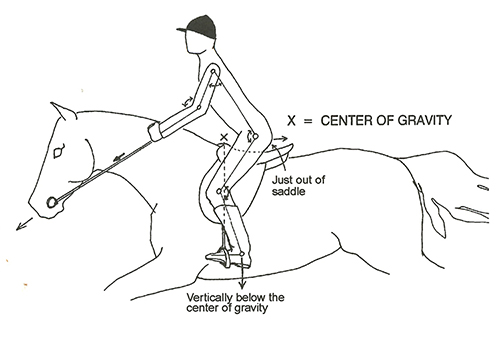
It really is a very valuable book and is still available on Amazon. You can even learn how to teach your horse to piaffe…
DESCRIPTION
The horse, in the highest degree of submission and collection, trots on the spot with lively, regular diagonal steps with a short but clear moment of suspension between the supporting steps.
The forehand is light with an elevated neck, the nose on the vertical and the poll being the highest point.
The front foot in suspension is lifted off the ground to halfway up the canon bone of the opposite one in support.
The croup is lowered with the hind legs well engaged, the foot in support vertically under the stifle and the one in suspension lifted off the ground to the height of the opposite fetlock joint.
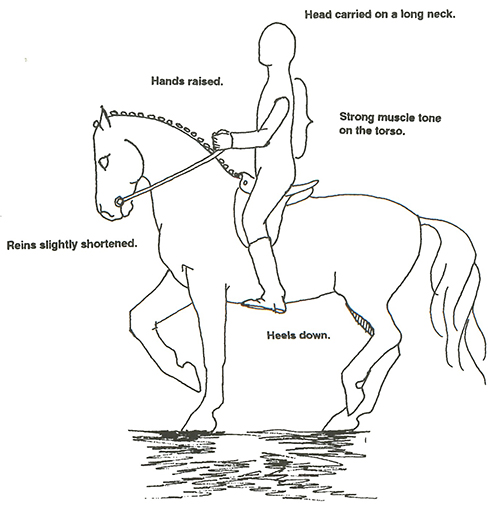
PURPOSE AND EFFECT
When properly done, piaffe paves the way for many of the exercises in collection. It is therefore an advantage, with suitable horses, to introduce it early in the training sequence.
It is also a natural movement, often seen produced by quite unschooled horses out of sheer excitement. This can be made use of, when it occurs, to introduce the movement.
The way of teaching it introduced here is without assistance-the rider on his own sitting in the saddle. It is sometimes necessary to have help from the ground by a person with a lunge whip, but this should be used with moderation so that the horse doesn’t become dependent on it.
DO
– With the horse in collected walk, ask for more collection by strengthening your position (raise your breastbone and the back of the neck), shortening the reins, and raising your hands with the elbows in.
– Keep the hind legs engaged straight behind the forelegs with your legs in contact on both sides with increased pressure, supported by the whip if necessary.
– Keep the poll high and gradually restrict the forward movement with quick half halts while forward pressure remains or even increases.
DON’T
– Drive with the seat in the trot rhythm.
– Move from side to side in the saddle.
– Indicate the trot rhythm with your hands.
– Apply the legs alternatingly.
– Use an assistant on the ground, if possible.
IT’S GONE WRONG WHEN
– There is no diagonal response.
– There is a canter response.
– The horse launches himself forward, hollow and resistant.
– The horse drops the bit and moves backward.
– He swings the quarters to the side.
– He pushes the forehand to the side.
– Lifts the legs diagonally, but without a moment of suspension.
– Raises the croup and leaves the front legs tilting forward.
YOU CAN PREVENT IT BY
– Repeating more strongly; maybe having assistance.
– Preventing it with the outside rein.
– Calming the horse down in loosening exercises at the walk.
– Moving both legs further forward, raising the hands and riding the horse energetically forward.
– Applying the same side leg on the hind leg button as well as the opposite rein.
– Applying the same side leg on the frontleg button and the same side rein; moving laterally in the saddle to the same side.
– Riding the horse forward in trot and then repeating from walk.
– Allowing more forward movement; raising the hands to raise the poll
COMMENTS
The teaching of piaffe is easier if the horse is somewhat “worked up” for whatever reason. Piaffe is a natural reaction in an excited horse, when he is prevented from moving forward. Look for the slightest tendency on the horse’s part to take a diagonal step and immediately reward by reducing the longitudinal pressure and allowing him to step forward in walk. To make a stronger impression, it is better to use the whip than the spurs.
